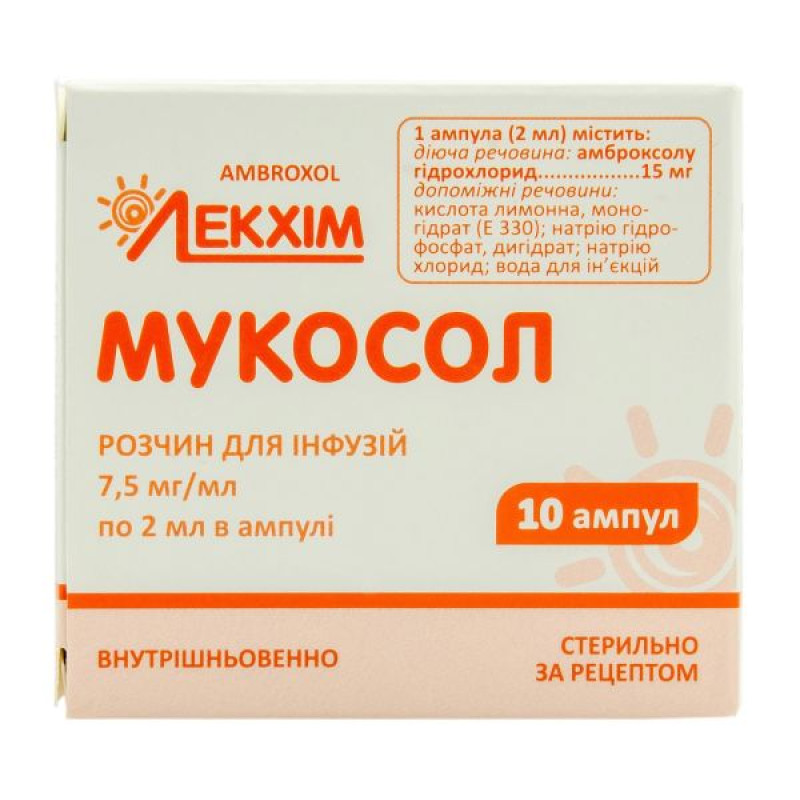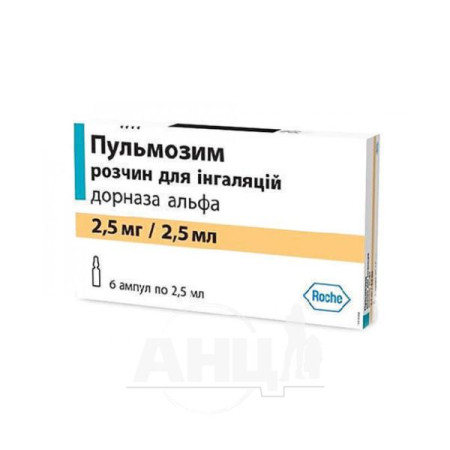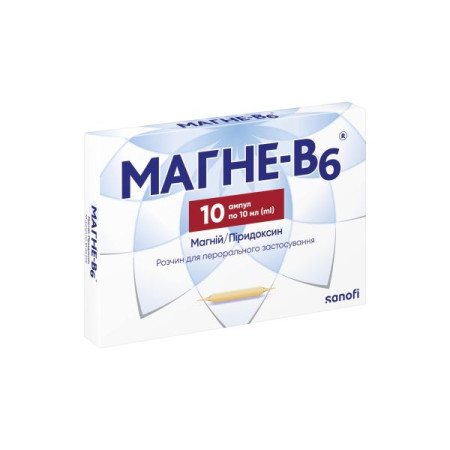Mucosol solution for infusions 7.5 mg/ml ampoule 2 ml No. 10

Translation of the instructions can be
MUCOSOL solution for infusion 7.5 mg/mlInstruction
For medical use of the medicinal product
Mucosol
(Mucosol)
Composition:
Active ingredient: ambroxol hydrochloride;
1 ampoule contains 15 mg of ambroxol hydrochloride;
Excipients: citric acid, monohydrate (E 330); sodium hydrogen phosphate, dihydrate; sodium chloride; water for injections.
Dosage form.
Solution for infusion.
Main physicochemical properties: clear colorless liquid.
Pharmacotherapeutic group.
Medicines used for coughs and colds. Mucolytics.
PBX code R05C B06.
Pharmacological properties.
Pharmacodynamics.
Ambroxol hydrochloride increases secretion in the respiratory tract. It also increases the secretion of pulmonary surfactant and stimulates the activity of the ciliary epithelium. These actions lead to improved mucus separation and excretion (mucociliary clearance). Improved mucociliary clearance has been demonstrated in clinical pharmacological studies. Activation of fluid secretion and increased mucociliary clearance facilitate mucus excretion and relieve cough.
In vitro studies have demonstrated that under the influence of ambroxol hydrochloride, the number of cytokines decreases, as well as the number of circulating and tissue-associated mononuclear and polymorphonuclear cells.
Antioxidant effects of ambroxol have also been observed in many preclinical studies.
After the use of ambroxol hydrochloride, the concentration of antibiotics (amoxicillin, cefuroxime, erythromycin) in bronchopulmonary secretions and sputum increases.
Pharmacokinetics.
Ambroxol hydrochloride is approximately 90% bound to plasma proteins in adults and 60-70% in newborns. The drug crosses the placental barrier and reaches the fetal lungs. The high volume of distribution of 410 l indicates a greater accumulation in tissues than in blood plasma, the concentration in lung tissues exceeds the corresponding figure in plasma by a factor of 17.
Metabolism and excretion.
Ambroxol hydrochloride is metabolized mainly in the liver by glucuronidation and to a lesser extent by cleavage to dibromantranilic acid (the latter accounts for approximately 10% of the dose), other minor metabolites are also formed. Studies of human liver microsomes have shown that the CYP3A4 enzyme is responsible for the metabolism of ambroxol hydrochloride to dibromantranilic acid.
3 days after administration, 4.6% of the dose is excreted unchanged, while 35.6% of the dose is excreted in conjugated form with urine.
The plasma half-life of ambroxol hydrochloride is approximately 10 hours. In neonates, after repeated intravenous administration, the half-life increases approximately twofold, indicating a decrease in clearance.
In severe liver disease, ambroxol clearance is reduced by 20-40%. In severe renal impairment, accumulation of ambroxol metabolites, namely dibromantranilic acid and glucuronides, is possible.
Ambroxol penetrates the blood-brain and placental barriers and into breast milk.
Clinical characteristics.
Indication.
To enhance the production of pulmonary surfactant in premature infants and newborns with respiratory distress syndrome.
Contraindication.
Known hypersensitivity to ambroxol or to any of the other components of the drug.
Interaction with other drugs and other types of interactions.
To date, no clinically significant interactions with other drugs have been identified.
The simultaneous use of Mucosol and cough suppressants may lead to excessive mucus accumulation due to suppression of the cough reflex; such a combination is possible only after a careful assessment by the doctor of the ratio of the expected benefit and the possible risk of use.
Application features.
If intravenous administration is carried out too quickly, in very rare cases headache, fatigue, exhaustion and a feeling of heaviness in the legs may occur.
Since ambroxol may increase mucus secretion, Mucosol, solution for infusion, should be used with caution in cases of impaired bronchial motility and increased mucus secretion (for example, in rare diseases such as primary ciliary dyskinesia).
Mucosol should be used with caution in patients with impaired renal function or severe liver disease. When using ambroxol, as with any other active substance that is metabolized in the liver and then excreted by the kidneys, accumulation of metabolites formed in the liver is observed in patients with severe renal failure.
Very rarely, severe skin reactions such as Stevens-Johnson syndrome or Lyell's syndrome (toxic epidermal necrolysis) have developed, which sometimes occurred against the background of the use of ambroxol. Most of these cases are associated with the underlying disease or with the simultaneous use of another drug. If any changes appear on the skin or mucous membranes, the use of ambroxol should be discontinued and a doctor should be consulted immediately.
Mucosol, solution for infusion, contains less than 1 mmol (23 mg) of sodium per ampoule.
Use during pregnancy or breastfeeding.
The ability to influence the reaction speed when driving vehicles or other mechanisms.
Apply to premature babies and newborns.
Method of administration and doses.
It has been proven that a total daily dose of 30 mg of ambroxol hydrochloride per 1 kg of body weight is effective.
The dose of the drug should be administered in 4 divided doses by slow intravenous infusion; it is recommended to administer each individual dose by intravenous infusion using an infusion pump device over at least 5 minutes.
Duration of treatment is 5 days.
The contents of 1-6 ampoules should be diluted in 250-500 ml of saline or Ringer's solution. The solution diluted with saline or Ringer's solution is stable from a physicochemical point of view for 24 hours at a temperature of 15-25 °C. From a microbiological point of view, if opening the ampoules and dilution are associated with a risk of microbiological contamination, the solution should be used immediately after preparation. If this is not the case, the user is responsible for the storage conditions and shelf life. If none of these solvents are available, 5% glucose solution can be used as an alternative. When using 5% glucose solution, the contents of the ampoules should be diluted immediately before use. If the solution is not used immediately after preparation, it must be discarded.
Children.
Use in premature babies and newborns as indicated.
Overdose.
There are no reports of specific symptoms of overdose. Symptoms observed in case of accidental overdose or medical error are similar to known adverse reactions observed when used at recommended doses and may require symptomatic treatment.
Adverse reactions.
Immune system/skin and subcutaneous tissue disorders: erythema; anaphylactic reactions (including shock), angioedema, skin rash, urticaria, pruritus and other hypersensitivity reactions, severe skin lesions: Stevens-Johnson syndrome, Lyell's syndrome.
Gastrointestinal: dry mouth, constipation, drooling, dry throat, nausea, vomiting, diarrhea, dyspepsia, abdominal pain.
Respiratory, thoracic and mediastinal disorders: rhinorrhea, shortness of breath (as a symptom of a hypersensitivity reaction).
Renal and urinary disorders: urination disorders.
In a broad sense, pathological phenomena at the site of drug administration: increased body temperature and chills, reactions from the mucous membrane.
Expiration date.
2 years.
Storage conditions.
Keep out of reach of children.
Store in the original packaging at a temperature not exceeding 25 ° C.
Incompatibility.
Mucosol should not be mixed with any medications other than those listed in the "Method of Administration" section.
Packaging.
2 ml in an ampoule; 10 ampoules in a pack, or 5 ampoules in a blister, 2 blisters in a pack.
Vacation category.
According to the recipe.
Producer.
Private Joint-Stock Company "Lekhim-Kharkiv".
Location of production and its address of place of business.
Ukraine, 61115, Kharkiv region, Kharkiv city, Severyna Pototskoho street, building 36.
There are no reviews for this product.
There are no reviews for this product, be the first to leave your review.
No questions about this product, be the first and ask your question.













